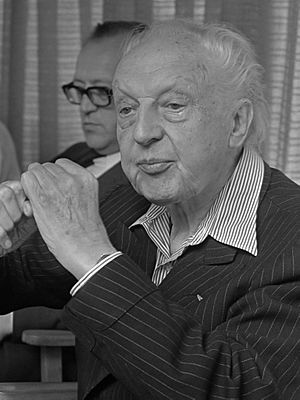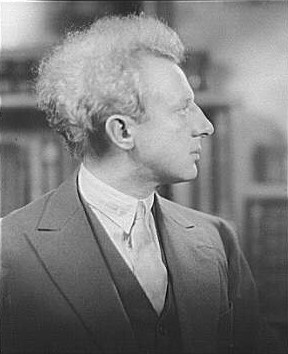Leopold Stokowski facts for kids
Quick facts for kids
Leopold Stokowski
|
|
|---|---|
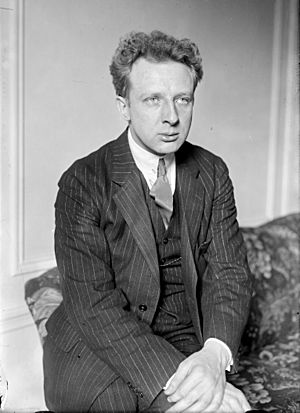 |
|
| Born |
Leopold Anthony Stokowski
18 April 1882 London, England
|
| Died | 13 September 1977 (aged 95) Nether Wallop, Hampshire, England
|
| Resting place | East Finchley Cemetery |
| Occupation |
|
| Known for | Music director of the Philadelphia Orchestra; Founder of the Hollywood Bowl Symphony Orchestra and the American Symphony Orchestra |
|
Notable work
|
Film: Walt Disney's Fantasia Carnegie Hall One Hundred Men and a Girl |
| Spouse(s) |
Olga Samaroff
(m. 1911; div. 1923)Evangeline Johnson
(m. 1926; div. 1937) |
| Children | 5 |
Leopold Anthony Stokowski (born April 18, 1882 – died September 13, 1977) was a famous British conductor. He was one of the most important conductors in the early and middle 1900s.
He is best known for working for a long time with the Philadelphia Orchestra. He also appeared in the Disney movie Fantasia with that orchestra. Stokowski was special because he conducted without a baton, using only his hands. He was also known for getting a rich, full sound from the orchestras he led.
Stokowski was the music director for many orchestras. These included the Cincinnati Symphony Orchestra and the Philadelphia Orchestra. He also founded several orchestras, like the All-American Youth Orchestra and the American Symphony Orchestra.
He conducted music for and appeared in several Hollywood films, especially Disney's Fantasia. Stokowski always supported new music and helped many modern composers. He gave the first performances of many new pieces during his 60-year career. He started conducting in 1909 and last appeared in public in 1975. He kept making recordings until June 1977, just a few months before he died at age 95.
Contents
Biography
Early life and musical training
Leopold Anthony Stokowski was born in London, England, on April 18, 1882. His father was a cabinet-maker from Poland, and his mother was from England. There was some mystery about his early life. For example, he spoke with a unique accent, even though he grew up in London.
Stokowski started studying music at a very young age. He joined the Royal College of Music when he was only 13. This made him one of the youngest students there. He sang in church choirs and later became an assistant organist. By age 16, he was already a member of the Royal College of Organists. In 1902, he became the main organist and choir director at St James's Church, Piccadilly. He also earned a music degree from The Queen's College, Oxford in 1903.
Starting his conducting career
In 1905, Stokowski moved to New York City. He worked as an organist and choir director at St. Bartholomew's Church. He was very popular there, but he soon left to become an orchestra conductor.
Stokowski then went to Paris to study conducting more. He heard that the Cincinnati Symphony Orchestra needed a new conductor. In 1908, he worked hard to get the job. He wrote letters and traveled to Cincinnati, Ohio, for an interview.
Stokowski became the conductor for the Cincinnati Symphony in late 1909. His first official conducting performance was in Paris on May 12, 1909. He played with his future wife, pianist Olga Samaroff. He was very successful in Cincinnati. He started "pops concerts" and played music by living composers. He conducted the first American performances of new works by composers like Edward Elgar. However, he left Cincinnati in 1912 because of disagreements with the orchestra's board.
Leading the Philadelphia Orchestra
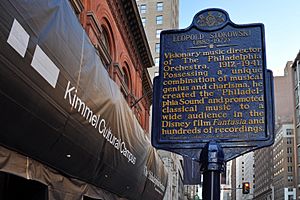
Two months later, Stokowski became the director of the Philadelphia Orchestra. He made his first performance in Philadelphia on October 11, 1912. This job brought him great success and fame.
Stokowski quickly became known as a "musical showman." He would make grand gestures, like throwing his sheet music on the floor. This showed he didn't need to read the score. He also tried new lighting in the concert hall. Sometimes, only his head and hands were lit, creating dramatic shadows. In 1929, he started conducting without a baton, using only his hands. This became his famous trademark.
Musically, Stokowski helped create the special "Stokowski sound," also known as the "Philadelphia Sound." He encouraged string players to use "free bowing" and brass players to use "free breathing." He also changed where musicians sat in the orchestra. He was the first conductor to use the seating plan most orchestras use today. This plan places the first and second violins together on the conductor's left.
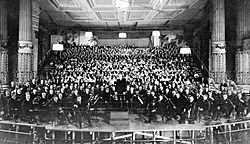
Stokowski also changed the music of some pieces he conducted. This was common for conductors before the mid-1900s. For example, he changed the ending of Tchaikovsky's Romeo and Juliet Fantasy Overture to end quietly. He also made his own version of Mussorgsky's Night on Bald Mountain. In the film Fantasia, the end of Night on Bald Mountain flowed into Schubert's Ave Maria.
Stokowski played many different kinds of music, including many new works. He was the only conductor to perform all of Arnold Schoenberg's orchestral pieces during the composer's lifetime. He also led the first American performances of four of Dmitri Shostakovich's symphonies. In 1916, he conducted the American premiere of Mahler's 8th Symphony, known as the Symphony of a Thousand.
He also introduced Igor Stravinsky's ballet The Rite of Spring to America in 1922. He gave its first staged performance in 1930. In 1933, he started "Youth Concerts" for younger audiences. These concerts are still a tradition in many American cities today. After some disagreements, Stokowski began to step back from the Philadelphia Orchestra in 1936. He shared conducting duties with Eugene Ormandy until 1941. He did not return to conduct the Philadelphia Orchestra until 1960.
Stokowski appeared as himself in the movie The Big Broadcast of 1937. He also conducted and acted in One Hundred Men and a Girl in 1937. In 1939, Stokowski worked with Walt Disney on the famous movie Fantasia. He conducted all the music for the film. He even got to talk to and shake hands with Mickey Mouse on screen!
Stokowski loved new recording technologies. He made sure most of the music for Fantasia was recorded using an early type of stereo sound called Fantasound. This system was very advanced for the 1930s.
When he returned in 1960, Stokowski conducted the Philadelphia Orchestra as a guest. He also made two recordings with them. His last concert with the Philadelphia Orchestra was in 1969. In 1969, he received the University of Pennsylvania Glee Club Award of Merit for his impact on music.
All-American Youth Orchestra
After his contract with the Philadelphia Orchestra ended in 1940, Stokowski quickly formed the All-American Youth Orchestra. Its musicians were between 18 and 25 years old. The orchestra toured South America in 1940 and North America in 1941, receiving great reviews. Stokowski made recordings with this orchestra. However, the orchestra stopped playing when America entered World War II.
Leading other orchestras
During the war, Stokowski became the chief conductor of the NBC Symphony Orchestra from 1941 to 1944. He conducted many new pieces with them, including the US premiere of Prokofiev's Alexander Nevsky. He also conducted works by British composers like Ralph Vaughan Williams and Gustav Holst.
In 1944, Stokowski helped create the New York City Symphony Orchestra. The goal was to make music affordable for everyone. Ticket prices were low, and concerts were held after work. Many early concerts were sold out. However, Stokowski resigned in 1945 due to disagreements with the board.
In 1945, he founded the Hollywood Bowl Symphony Orchestra. This orchestra played for two years. Stokowski made many recordings with them. A 1949 cartoon called "Long-Haired Hare" even made fun of Stokowski at the Hollywood Bowl, with Bugs Bunny playing the conductor.
From 1946, Stokowski often appeared as a guest conductor with the New York Philharmonic. He led the US premiere of Prokofiev's 6th Symphony in 1949. He also made important recordings with them.
International career and later years
In 1951, Stokowski began an international career. He toured England and made his first recording with a British orchestra. He then toured Germany, Holland, Switzerland, Austria, and Portugal. For the next 20 years, he spent summers conducting abroad and winters in the United States. He conducted many of the world's best orchestras and made recordings with them.
Stokowski returned to the NBC Symphony Orchestra in 1954 for recordings. After the orchestra was officially disbanded, it reformed as the Symphony of the Air. Stokowski was its music director and they performed many concerts and made recordings until 1963. From 1955 to 1961, Stokowski was also the Music Director of the Houston Symphony Orchestra. He led the first performance of Mysterious Mountain by Alan Hovhaness there.
In 1962, at age 80, Stokowski founded the American Symphony Orchestra. He continued to support 20th-century composers. One of his most famous premieres with this orchestra was Charles Ives's 4th Symphony in 1965. He also recorded with famous soloists like pianist Glenn Gould. Stokowski was the music director for the American Symphony Orchestra until 1972, when he moved back to England at age 90.
He continued to conduct in public for a few more years. However, his health made him focus on making recordings. Eyewitnesses said he often conducted sitting down in his later years. But sometimes, he would stand up and conduct with amazing energy. His last public performance in the UK was on May 14, 1974. His final public appearance was on July 22, 1975, in France.
Stokowski made his last world premiere in 1973, at age 91. He conducted Havergal Brian's 28th Symphony for a BBC radio broadcast. He continued to make recordings even after he stopped performing in concerts.
Leopold Stokowski died from a heart attack on September 13, 1977, in Nether Wallop, England. He was 95 years old. His very last recordings were made shortly before his death. He is buried at East Finchley Cemetery.
Recording achievements
Stokowski made his first recordings with the Philadelphia Orchestra in October 1917. He was very good at using early recording methods. When electric recording came out in 1925, he conducted the first orchestral electric recording made in America. He was also the first conductor in America to record all four of Brahms' symphonies.
Stokowski made the first US recordings of many important works. These included Beethoven's 7th and 9th Symphonies, Antonín Dvořák's New World Symphony, and Pyotr Ilyich Tchaikovsky's 4th Symphony. He also recorded Sergei Rachmaninoff's 2nd Piano Concerto with the composer playing the piano.
Stokowski and the Philadelphia Orchestra also took part in early experiments with long-playing records and stereo sound in the 1930s. He recorded for many different record labels throughout his life.
In 1954, Stokowski made his first commercial stereo recordings. He was very careful about where musicians were placed during recording sessions. He worked closely with the recording engineers to get the best sound. The music he conducted for Fantasia was released as a soundtrack album. Later, it was released in stereo and on compact disc.
In 1958, Stokowski signed with Everest Records, known for its clear sound. Some of his notable Everest recordings included Tchaikovsky's Francesca da Rimini and Holst's The Planets. Several of his televised concerts have also been released on DVD.
In 1973, Stokowski conducted the International Festival Youth Orchestra in London. This orchestra had 140 of the world's best young musicians. They performed Tchaikovsky's Fifth Symphony. One critic said, "Stokowski rallied them as though it was a vintage Philadelphia concert of the 1920s."
Personal life
Marriages and family
Stokowski was married three times. His first wife was American pianist Olga Samaroff. They were married from 1911 to 1923 and had one daughter, Sonya Maria Noel Stokowski.
His second wife was Evangeline Love Brewster Johnson, an artist. They were married from 1926 to 1937 and had two daughters, Gloria Luba Stokowski and Andrea Sadja Stokowski.
On April 21, 1945, Stokowski married actress Gloria Vanderbilt. They had two sons, Leopold Stanislaus Stokowski and Christopher Stokowski. They divorced in 1955.
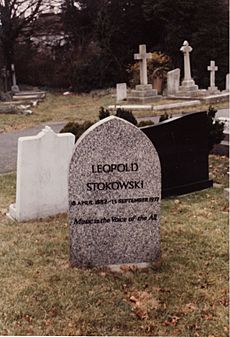
Legacy
After Stokowski died, some old rumors about him came back. People said his name and accent were fake, or that he wasn't a good musician. However, attitudes towards Stokowski have changed a lot since his death.
In 1999, music expert David Mellor wrote that Stokowski is now seen as the "father of modern orchestral standards." He said Stokowski had a "magical gift" for getting a beautiful sound from orchestras. He also loved recording and always looked for better sound quality. Mellor added that Stokowski is now recognized as an excellent conductor of 19th and 20th-century music.
The Looney Tunes cartoon "Long-Haired Hare" makes a funny tribute to Stokowski. Bugs Bunny pretends to be him at the Hollywood Bowl. The cartoon gently jokes about Stokowski's habit of conducting without a baton.
There is a statue of Stokowski shaking hands with Mickey Mouse in the lobby of Disney's Contemporary Resort in Walt Disney World in Orlando, Florida. This statue recreates a famous moment from the movie Fantasia.
Notable concert premieres
- Edgard Varèse, Ameriques, Philadelphia Orchestra, Philadelphia, April 9, 1926
- Sergei Rachmaninoff, Fourth Piano Concerto, with the composer as soloist, Philadelphia Orchestra, 1927
- Sergei Rachmaninoff, Rhapsody on a Theme of Paganini, with the composer as soloist, Philadelphia Orchestra, Baltimore, November 7, 1934
- Sergei Rachmaninoff, Third Symphony, Philadelphia Orchestra, 1936
- Arnold Schoenberg, Violin Concerto, with Louis Krasner as soloist, Philadelphia Orchestra, December 6, 1940
- Arnold Schoenberg, Piano Concerto, with Eduard Steuermann as soloist, NBC Symphony Orchestra, New York, February 16, 1944
- Nathaniel Shilkret, Concerto for Trombone, with Tommy Dorsey as soloist, New York City Symphony Orchestra, February 15, 1945
- Elie Siegmeister, Symphony No. 1, New York Philharmonic, New York City, October 30, 1947
- Alan Hovhaness, Symphony No. 2, Mysterious Mountain, Houston Symphony Orchestra, Houston, Texas, 1955
- Charles Ives, Fourth Symphony, American Symphony Orchestra, Carnegie Hall, New York, April 26, 1965
Notable recording premieres
- Arnold Schoenberg, Gurre-Lieder, Philadelphia Orchestra, April 9 and 11, 1932, RCA Victor
- Jean Sibelius, Fourth Symphony, Philadelphia Orchestra, April 23, 1932, RCA Victor
- Sergei Rachmaninoff, Rhapsody on a Theme of Paganini, with the composer as soloist, Philadelphia Orchestra, December 24, 1934, RCA Victor
- Dmitri Shostakovich, Sixth Symphony, Philadelphia Orchestra, August 1940, RCA Victor
- Ralph Vaughan Williams, Sixth Symphony, Philharmonic Symphony Orchestra of New York, February 21, 1949, Columbia
- Gustav Mahler, Eighth Symphony, Philharmonic Symphony Orchestra of New York, Westminster Choir, Schola Cantorum of New York, Public School Boys' Chorus, April 9, 1950, NYP Editions (first complete recording)
See also
 In Spanish: Leopold Stokowski para niños
In Spanish: Leopold Stokowski para niños
- Fantasia (1940 Walt Disney animated movie), which stars Stokowski leading the Philadelphia Orchestra and performing, among other pieces of music, his transcription of Bach's Toccata and Fugue in D minor, BWV 565, as the opening piece of the program
- List of famous Poles
- Long-Haired Hare (1949 Bugs Bunny cartoon), which pokes gentle fun at Stokowski's conducting style, including his habit of leading the orchestra without a baton



